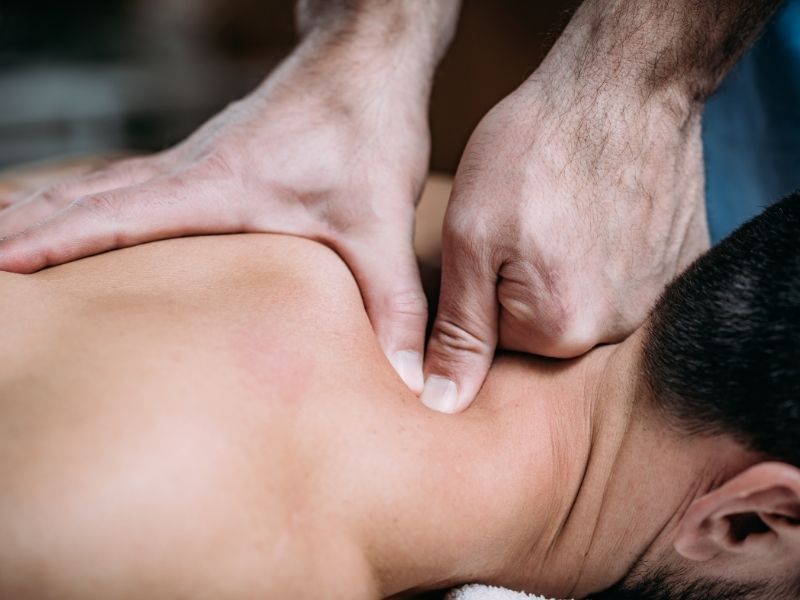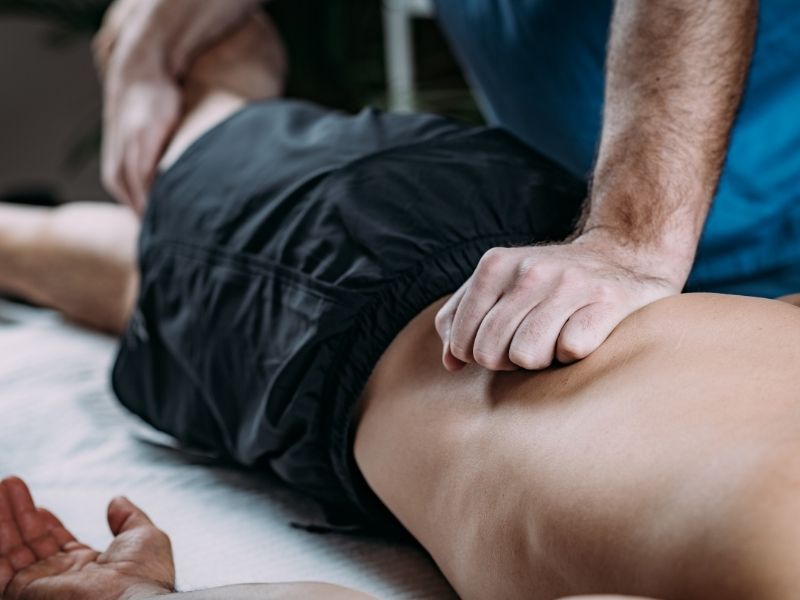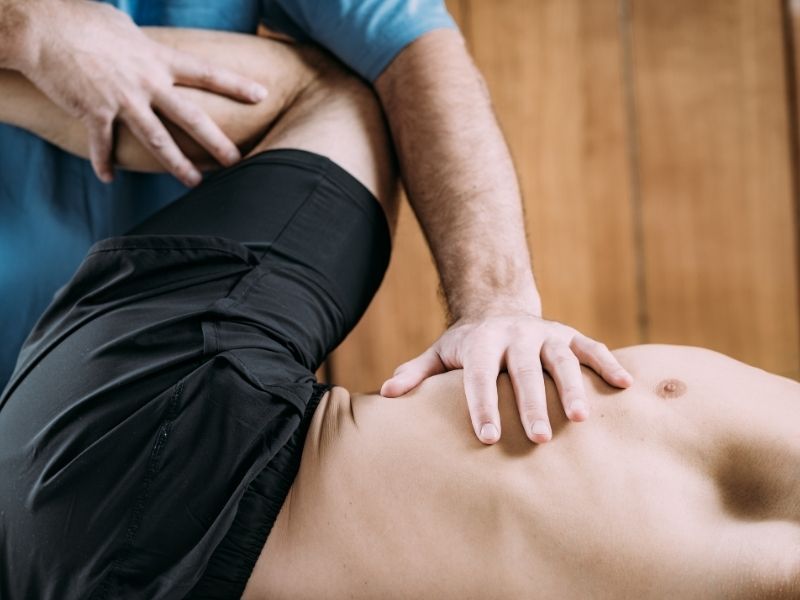Can Massage Therapy Help With Herniated Discs?

Chronic pain that may have a structural component such as a herniated disc can be continuous or intermittent. Either way, it is very uncomfortable and usually worsens by standing for an extended period or moving the spine.
Worse still, imaging studies are often vague and inaccurate to predict the outcome (1). Thus, most people need to try several therapies before they can find significant relief.
Doctors often recommend physical therapy for herniated disc pain, but will a massage help a bulging disc? Several people have had an excellent experience, while others prefer medical treatment. In some cases, only surgery provides successful relief (2).
In this article, we’re covering this topic thoroughly, and you will know what to expect from a massage for herniated disc in lower back pain.
Is it OK to get a massage with a herniated disc?
Massage sessions can be prescribed as a part of physical therapy for herniated disc pain. There is nothing wrong with it as long as it is performed by a licensed massage therapist. Massage for herniated discs is not a superficial type of massage. Certain therapies require traction and specific movements to achieve a certain degree of improvement. Thus, it is not meant to be performed outside of the therapist’s office (3).
Massage therapy can really help if you experience these symptoms:
- Stiffness in your spine and continuous pain
- Avoidance behaviors trying to prevent pain
- Depression, anxiety, or stress due to your condition
- Worsening sleep quality caused by your herniated disc
We usually hear about herniated discs in the lower back, but that’s not the only painful area to consider. Sometimes, chronic neck pain can be caused by a herniated cervical disc as well.
Massage for herniated disc in neck pain may improve the condition and provide temporary but significant relief. Techniques used are different than the lumbar region, but it should also be performed by a licensed therapist for safety and better results.
How do you massage a herniated disc?
There are several types of massage for herniated disc pain. Additional physical therapy techniques are often employed as well, including joint mobilization or pumping manual therapy techniques.
The most common massage techniques to improve symptoms of a herniated disc include (3, 4):
- Deep tissue massage: This is probably the most effective type of massage for herniated discs. As the name implies, the therapist will use a progressively deeper pressure on your back to reach the spine, relieve tension, and reduce muscle tension.
- Traction movements: This is an advanced technique only performed by skilled hands. It is meant to release the nerve roots pressed by the bulging or herniated disc. The therapist will use a combination of pulling movements to gently decompress your spine and improve your symptoms.
- Hot and cold massage therapy: Your therapist may alternate deep tissue massage and traction movements with hot and cold therapy for better results. This type of therapy alternates between high and low temperatures to increase the blood flow to the trouble area.
Does massage therapy help bulging disc?
If OTC anti-inflammatories only provide partial relief, will a massage help a bulging disc?
We should make clear that the only way to “fix” a herniated disc is through surgical treatment. However, massage therapy provides significant improvements. They are usually temporary improvements and mainly work in patients with symptoms aggravated by biopsychosocial elements (stress, anxiety, pain avoidance behaviors, or an emotional response to pain) (5).
As mentioned above, imaging studies are often elusive. People with no apparent structural problems could sometimes experience worse symptoms than people with them.
Research suggests that discs may bulge and reabsorb in nearly 70% of cases, and pain in such circumstances can be challenging to trace back to a single cause (6). There is clearly much more going on than just a bulging disc.
Massage as physical therapy for herniated disc pain manages those extra components that influence chronic back pain. As such, it won’t be a definite improvement in many cases but may help cope with the symptoms, improving the quality of life through a nonsurgical alternative.
What is the fastest way to heal a herniated disc?
Massage for herniated disc in lower back pain is only one measure we can take, but it isn’t always the fastest way to improve pain. It usually takes several massage sessions to experience significant relief.
In the meantime, you can use other therapies, and each has its own benefits (7):
- Medications: In some cases they can be an important component if pain is significant. As mentioned before they won’t “fix” the problem, but you will experience improvements in your quality of life. It is a short-term measure for herniated discs.
- Muscle strengthening and core stabilizing exercises: Stronger back and core muscles will support the spine and relieve compensation.
- Epidural injections: Instead of using oral pain relievers, the next step, if recommended by your physician, may be trying epidural injections. They are administered directly on your spine and can potentially provide relatively rapid pain relief. They also reduce inflammation levels but won’t change the structure of the spine.
- Surgical treatment: Conservative treatment in severe cases may not be enough to resolve herniated disc pain. At this point, it would be a through discussion with your doctor and surgeon.
Does a herniated disc ever fully heal?
Not everyone requires surgery or spinal injections to improve their symptoms. In many cases, people will have a significant improvement with conservative therapy.
It’s important also to remember that surgical treatment is not a long-term guarantee, and some people start experiencing low back pain symptoms once again years after treatment (8).
So in summary when asking the question can massage therapy help with herniated discs, dealing with discs can be challenging, but throughout the process, physical therapy for herniated disc pain, including massage therapy, stabilizing exercises, core strengthening, and other strategies can speed up the process and make you feel better.
References:
- Kim, J. H., van Rijn, R. M., van Tulder, M. W., Koes, B. W., de Boer, M. R., Ginai, A. Z., … & Verhagen, A. P. (2018). Diagnostic accuracy of diagnostic imaging for lumbar disc herniation in adults with low back pain or sciatica is unknown; a systematic review. Chiropractic & manual therapies, 26(1), 1-14.
- Gregory, D. S., Seto, C. K., Wortley, G. C., & Shugart, C. M. (2008). Acute lumbar disk pain: navigating evaluation and treatment choices. American family physician, 78(7), 835-842.
- Lü, L. J., Ke, X. A., Mao, X. D., Chen, X. J., Wu, F. C., & Tong, H. J. (2010). Clinical observation of post-extension pulling massage in treating lumbar disc herniation. Zhongguo gu shang= China journal of orthopaedics and traumatology, 23(10), 790-791.
- Xiaohua, L. (2013). Therapeutic Effect of Traction and Manual Massage for Lumbar Disc Herniation. Chinese Medicine Modern Distance Education of China, 15.
- Hunt, E. R., Baez, S. E., Olson, A. D., Butterfield, T. A., & Dupont-Versteegden, E. (2019). Using massage to combat fear-avoidance and the pain tension cycle. International Journal of Athletic Therapy and Training, 24(5), 198-201.
- Ming Zhong, M. D., & Liu, J. T. (2017). Incidence of spontaneous resorption of lumbar disc herniation: a meta-analysis. Pain physician, 20, E45-E52.
- Hahne, A. J., Ford, J. J., & McMeeken, J. M. (2010). Conservative management of lumbar disc herniation with associated radiculopathy: a systematic review. Spine, 35(11), E488-E504.
- Clark, R., Weber, R. P., & Kahwati, L. (2020). Surgical management of lumbar radiculopathy: a systematic review. Journal of general internal medicine, 35(3), 855-864.
Sam Visnic
I’ve spent my life studying the fundamental aspects of human health with a focus on movement and clinical massage therapy. In a world of specialists, surgical procedures, drugs and quick fix remedies, I’m committed to finding and developing strategies that help people stuck at the “gap”. Over the last 20 years I’ve studied dozens of systems and methodologies for uncovering the root cause of aches and pains, along with postural and movement issues. Pain science, the art and science of hands-on soft tissue massage techniques, myofascial release, and coaching movement is essential in my practice. Integrating different methods but above all deciphering WHEN to use different techniques with different people and situations, along with integration of movements that people want to be able to do again is the key to long term success with my incredible track record with clients. Understanding the various elements that contribute to conditions and the power of communication and education makes my Release Muscle Therapy program separate from other hands-on therapy approaches.
Blogs You May Be Interested In
Categories
-
Deep Gluteal Pain Syndrome
-
Deltoids
-
Fallbrook
-
Foam Rolling
-
Glutes
-
Hamstrings
-
Hypnosis For Pain
-
Lats
-
Levator Scapulae
-
Lifestyle
-
Massage Therapy
-
Mobility
-
Movement and Exercise
-
Murrieta
-
Muscles
-
Nutrition
-
Obliques
-
Pain
-
Pectorals
-
Piriformis
-
Plantar Fasciitis
-
Product Review
-
Psoas
-
Quadratus Lumborum
-
Quadriceps
-
Rhomboids
-
Serratus Anterior
-
SI Joint
-
Sternocleidomastoid
-
Stretching
-
Subscapularis
-
Temecula
-
TMJ
-
Trapezius
-
Uncategorized
















